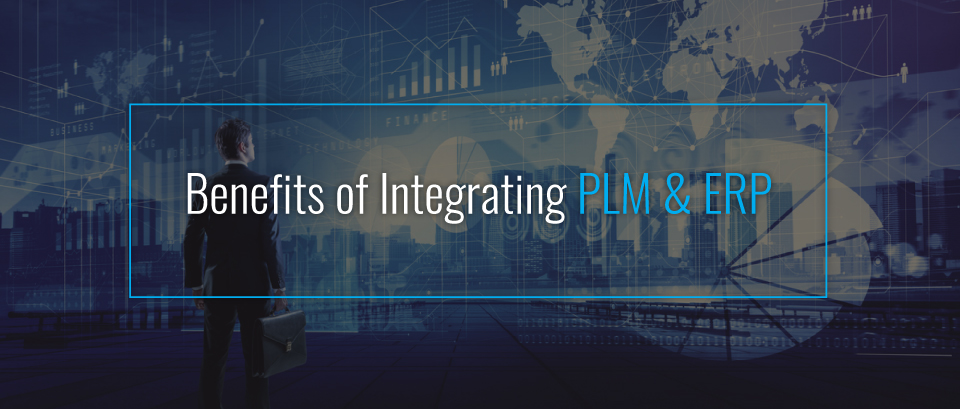
The Role of ERP and PLM

Many businesses are already enjoying the benefits of product lifecycle management (PLM) and enterprise resource planning (ERP). While PLM helps them manage their complete product development stage and its processes, ERP facilitates supply chain management, including inventory, logistics, pricing, and payment.
Though useful in their own rights, the integration of these two systems boosts their capabilities substantially. Moreover, many PLM and ERP experts believe that, together, these systems bring out their fullest potential.
Let us deep-dive into how ERP and PLM work together and the benefits of their integration.
What is PLM?
Product lifecycle management (PLM) is a process of managing complex product development from ideation, designing, manufacturing, up to the disposal stages. It is a software solution that integrates data, workflows, business systems, and people in a value chain to manage the entire lifecycle of a product efficiently and cost-effectively.
What is ERP?
ERP is a procedure that integrates all the core processes of a company such as HR, finance, procurement, manufacturing, services, supply chain, and the like, into one system. However, modern ERP systems have evolved beyond the basics to offer efficiency, visibility, and intelligence across all your business aspects.
Product Lifecycle Management (PLM) vs. Enterprise Resource Planning (ERP)
As the name suggests, one of the main differences between the two systems is that PLM is mainly about the ideation and planning of a product while ERP, on the other hand, is about execution, i.e., the making of that product. Typically, PLM is used by engineers or product designers and ERP by manufacturing operations personnel.
Product Lifecycle Management (PLM) is involved more during the ideation, innovation, and design processes of a product. ERP helps manage the quality, efficiency, and cost-control aspects of a product in its manufacturing and supply stages.
This means PLM focuses on the configuration and relation between the various components of a product, while ERP deals with the movement of materials such as inventory management, production scheduling, and logistics. Clearly, both the systems are diverse, and each system’s capabilities are not replaceable with the other’s.
| PLM vs. ERP Capabilities | |
| PLM | ERP |
| Bill of materials (BoM) management | Purchasing |
| Item management | Inventory management |
| Change management | Order management |
| Document management | Accounting and finance |
| Compliance management | Schedules |
| Product designing | Product manufacturing |
Why does a business need PLM-ERP integration?
Having real-time access to comprehensive product information, including costs, is crucial for an efficient product development process. Besides, getting accurate calculations means working with multiple business systems and then verifying the data back in your isolated Product Lifecycle Management system.
When your PLM and ERP are not integrated, your R&D department ends up spending a lot of time re-entering data and fixing related errors, working with wrong product forecasting, providing incomplete information instructions and material master records, and following up on process delays.
Therefore, you need to centralize the data between your PLM and ERP systems by integrating them to ensure an efficient flow of the product life cycle.
The benefits of PLM and ERP integration
PLM and ERP business systems are critical for innovative development and profitable launch of products. The two software systems are complementary, and you cannot choose one over the other. Their integration ensures the success of a product. Let us look at the various benefits of PLM-ERP integration.
1. Higher efficiency
PLM-ERP integration can enhance process efficiency and productivity. Consequently, it helps you increase the bottom line of your company as well. You gain access to real-time data as well as see data transfer in real-time. This means you are always updated on the current status and can make modifications as required. Your ability to detect probable improvement areas enhances as you have more operations-related information at your disposal.
The PLM-ERP combination automates the process of updating and transferring data. Thus, your employees can be freed from the mundane task of repetitive data input. They can utilize their valuable time in executing more business-critical, skill-relevant tasks, leading to increased productivity.
2. Cost reduction
The ability to save costs is one of the top benefits of PLM-ERP integration. When the data starts to transfer back and forth automatically between both the systems, the manual intervention is minimalized.
In an integrated environment, you would need to feed the data only once instead of twice. The data added can then move directly to the other system, without any interference. As a result, the scope for errors decreases considerably and increases data accuracy. Integration also nullifies the chances of any inconsistencies between the systems.
With increased data accuracy, a business can place their purchase orders more confidently, helping you to avoid supply shortage as well as save money on excessive supplies. Furthermore, you can ensure the on-time delivery of orders without having to spend on hiring additional supply chain resources.
3. Higher customer satisfaction
Centralized data ensures higher visibility into your business operations, allowing you to recognize the potential areas for cost reduction.
Undeniably, when your errors are minimized, efficiency is increased, processes are improved, your customers are happier and satisfied. Despite the PLM and ERP functionalities supporting the internal systems, their combination can help increase customer satisfaction by fulfilling their orders quickly and accurately.
What is more, the PLM-ERP integration can enable you to adjust prices to expand your customer base. With many of your processes being automated, your employees can focus on order fulfilment, customer satisfaction, and product improvement, among other vital tasks. This integration also facilitates your option to integrate Customer Relationship Management (CRM), which can increase your ability to achieve the highest level of customer satisfaction through relevant and accurate data.
4. Improved collaboration
Seamless and clear communication among multiple departments is crucial for business success, especially in larger organizations. Even the slightest disparity in the information or incompatibility of formats uploaded by different employees can cause miscommunication, leading to errors, extra costs, and revenue loss.
When your business systems are integrated, all the stakeholders are directed to a single source of data. For instance, when someone needs to modify any data, especially at the last minute, all the stakeholders must be informed of the changes simultaneously. An integrated system automates the updating of data to everyone. Besides, one can even view all the changes made in the past to understand how the products or processes have progressed over time.
System integration encourages the exchange of information between multiple departments, which can lead to surprising improvements in your business. Access to the overarching data of their business operations helps all the departments align better, increasing performance and productivity.
Which comes first? PLM or ERP?
Our customers often ask which system needs to be implemented first—PLM or ERP? With every business now recognizing the value of the system integration, they want to ensure each system is placed well for seamless end-to-end integration.
Logically, one must start with the origin of a product, where it is ideated and designed, and that is PLM. However, many businesses believe ERP implementation comes first as it deals with the financial and operational aspects.
In all honesty, the right answer is neither PLM nor ERP. It makes more sense to build and implement both the systems together at the same time, as it ensures the integration is done specifically to your business needs
Successful integration involves a complete understanding of the data, including how and where it is stored and its real meaning. Often, a Master Data Management project needs to be undertaken before implementing the ERP or PLM systems.
Learn how To-Increase and can help you seamlessly integrate your PLM and ERP systems.
[embeddoc url=”https://plmes.io/wp-content/uploads/2020/11/PLM-vs.-ERP-infographic.pdf” download=”all” viewer=”google”]

Don’t hesitate to contact Thanh for advice on automation solutions for CAD / CAM / CAE / PLM / ERP / IT systems exclusively for SMEs.
Luu Phan Thanh (Tyler) Solutions Consultant at PLM Ecosystem Mobile +84 976 099 099
Web www.plmes.io Email tyler.luu@plmes.io
